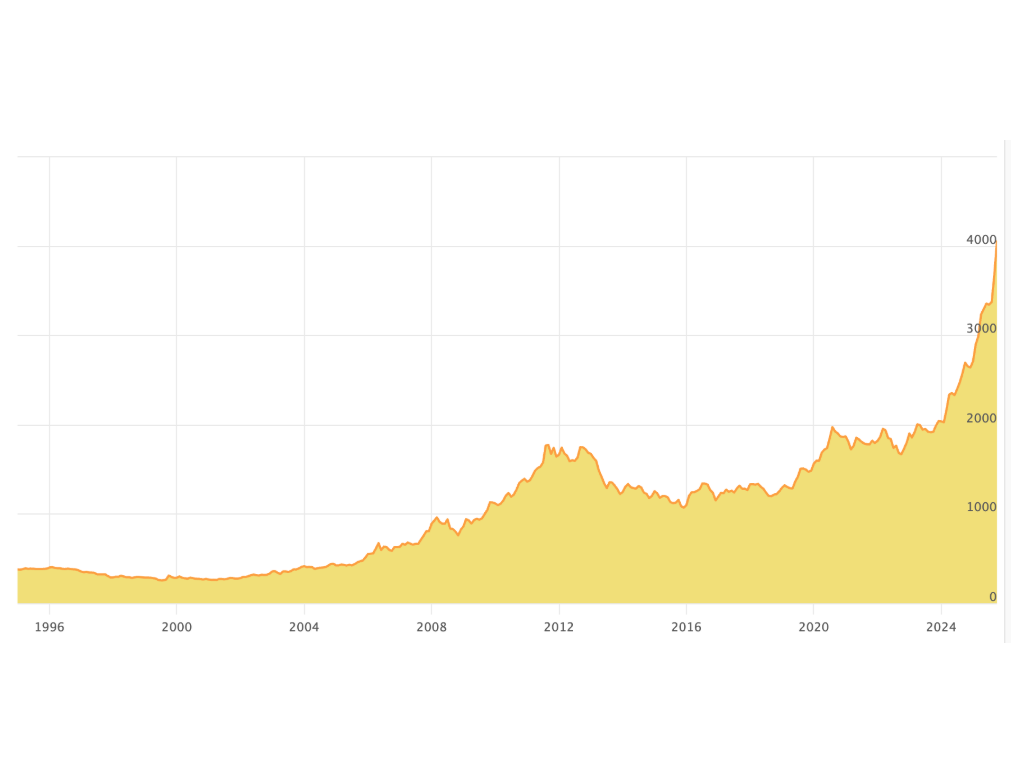
The so-called ‘magnificent 7’ tech stocks have gotten a lot of attention during the current market rally, but there’s one investment asset that has surged even faster, and is actually, in aggregate, more valuable than all of the M7 stocks combined.
We’re talking about gold, which has recently been trading at an all-time record of $4,300 an ounce. That’s about 65% higher than the price on January 1. In the stock market, we talk about ‘market cap,’ which is the sum you get when you multiple all of a company’s outstanding shares by its current share price. If you were to multiply all the outstanding shares of Nvidia, Microsoft, Apple, Alphabet, Amazon, Meta and Tesla by their respective current share prices, and add them all together, the resulting sum would be significantly less than the $30 trillion ‘market cap’ of gold.
In fact, the total amount of gold in the market times its price per ounce is 1.5 times the total aggregate market cap of the Magnificent 7.
This has been a strange year for gold. Conventional wisdom says that people buy gold when the world is uncertain—and that often means those all-too-frequent times when the investment markets are plummeting. This year, the markets are up and gold is up more. Does that mean investors are skittish and rushing to what they believe is a more reliable store of wealth?
No doubt some investors are worried about high levels of government debt, and prefer gold to government bonds and investments in the U.S. dollar. Others may be concerned about a global environment marked by unprecedented trade tensions, economic uncertainty and recent market volatility.
But the skittish investors that are driving the bull market in gold appear to be central banks around the world. A recent survey showed that Poland has purchased 67.1 tons of gold on the open market since the start of the year, while Kazakhstan (32.4 tons), China (22.7 tons), Turkey (21.4), Czechia (14.1), Cambodia (8.0), Ghana (5.5), Qatar (4.4), India (3.8) and Serbia (3.2) are all stockpiling the shiny metal.
Do they know something we don’t?
Among all countries, the United States has by far the largest gold reserve; its 8,133.46 tons represents about 77.9% of its total foreign reserves. Germany (3,350.25), Italy (2,451.84), France (2,437.0), Russia (2,329.63) and China (2,302.26) fit comfortably in the second tier of gold ownership, followed by Switzerland, India, Japan, Turkey, the Netherlands, Poland, Taiwan and Portugal.
At the other end of the spectrum, Canada is one of the few countries that holds no gold in its official reserves. The Bank of Canada sold off its bullion holdings over the last 20 years. Norway’s Norges Bank sold all of its bullion in 2004, retaining only seven bars and some coins for exhibition purposes.
How long will this bull market last? Who knows? As the reader can see from the accompanying graph, gold’s price has bounced around a bit over the years, and there have been long periods of zero return. (Remember, gold bullion doesn’t pay dividends.) The major rally that started in March of 2022 might be peaking as you read this, or it might (who knows?) continue to test new highs. The central banks seem to be worried about something; whatever it is, it might cause more investors and traders to spook at some point in the future and look for a traditional safe haven.

Source:
.png)
Access our comprehensive, unbiased financial guides here.